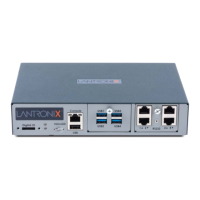10: Device Ports
EMG™ Edge Management Gateway User Guide 230
demand connection will be started for each, waiting for IP traffic destined for a remote
network.
When IP traffic needs to be sent, the EMG unit dials the appropriate Dial-out Number for the
site, and if the remote peer requests PAP or CHAP authentication, provides the Dial-out
Login and Dial-out Password as authentication tokens. Once authenticated, a PPP session
will be established using either negotiated IP addresses or specific IP addresses (determined
by the Negotiate IP Address setting). The PPP connection will stay active until no IP traffic is
sent for Modem Timeout seconds. Once the timeout has expired, the PPP connection will be
terminated and will not be reestablished for at least Restart Delay seconds.
CBCP Server and CBCP Client
Callback Control Protocol (CBCP) is a PPP option that negotiates the use of callback where the
server, after authenticating the client, terminates the connection and calls the client back at a
phone number that is determined by the CBCP handshake. For more information on CBCP, see
http://technet.microsoft.com/en-us/library/cc957979.aspx
. CBCP is used primarily by Microsoft
PPP peers. CBCP supports two options for determining the number to dial on callback: the client
can specify a user-defined number for the server to dial on callback, or the client can request the
server use an administrator-defined number to dial on callback. Optionally, some servers may also
allow "no callback" as an option.
CBCP Server
The EMG waits for a client to call the EMG unit, establishes a PPP connection, authenticates the
user, and negotiates a dial-back number with the client using CBCP. If the EMG is able to
determine a dial-back number to use, it hangs up and calls the dial-back number.
When a call is received, a PPP connection is established, and the user will be authenticated via
PAP or CHAP (configured with the Authentication setting). For PAP, the Local/Remote list will be
used to authenticate the login and password sent by the PPP peer. For CHAP, the CHAP
Handshake Host/User Name and Secret/User Password will be used to authenticate CHAP
Challenge response sent by the PPP peer. If the remote peer requests PAP or CHAP
authentication from the EMG unit, the Remote/Dial-out Login and Remote/Dial-out Password
will be provided as authentication tokens. Once authenticated, the CBCP handshake with the
client determines the number to use for dial-back. The EMG unit will present the client with the
available options: if the authenticated user is a Local/Remote User with Allow Dial-back enabled
and a Dial-back Number defined, the administrator-defined option is allowed; if this is not the case,
the user-defined number is allowed. Additionally, if CBCP Server Allow No Callback is enabled,
the client can also select no callback (the PPP connection established at dial-in will remain up).
The client will select from the available callback options. If the EMG unit can determine a dial-back
number to use, it will hang up and wait Dial-back Delay seconds before initiating the dial-back (if
the dial-back fails, the EMG will try Dial-back Retries times to dial-back). The EMG unit will call
back the previously authenticated remote peer, and if the remote peer requests PAP or CHAP
authentication, provide the Remote/Dial-out Login and Remote/Dial-out Password as
authentication tokens. Once authenticated, a PPP session will be established using either
negotiated IP addresses or specific IP addresses (determined by the Negotiate IP Address
setting).
CBCP Client
The EMG unit will dial out to a CBCP server, establish a PPP connection, negotiate a callback
number with the server using CBCP, terminate the connection, and wait for the server to call back.
The EMG unit dials the Dial-out Number, and if the remote peer requests PAP or CHAP
authentication, provides the Remote/Dial-out Login and Remote/Dial-out Password as
authentication tokens. Once authenticated, the CBCP handshake with the server determines the

